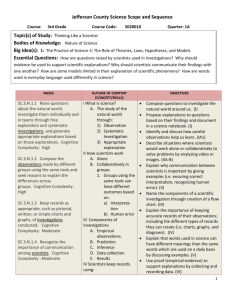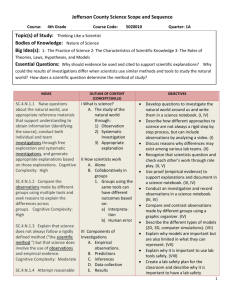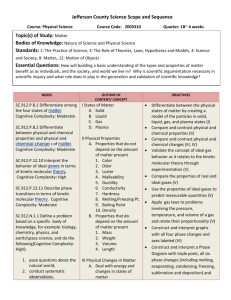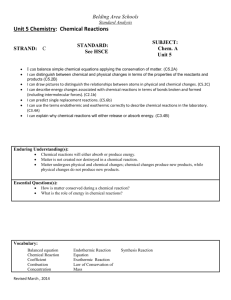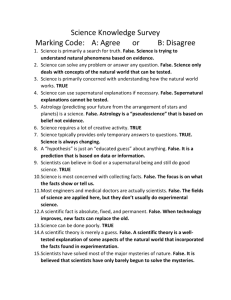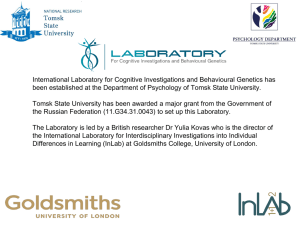Chemical Reactions - Jefferson County School District
advertisement
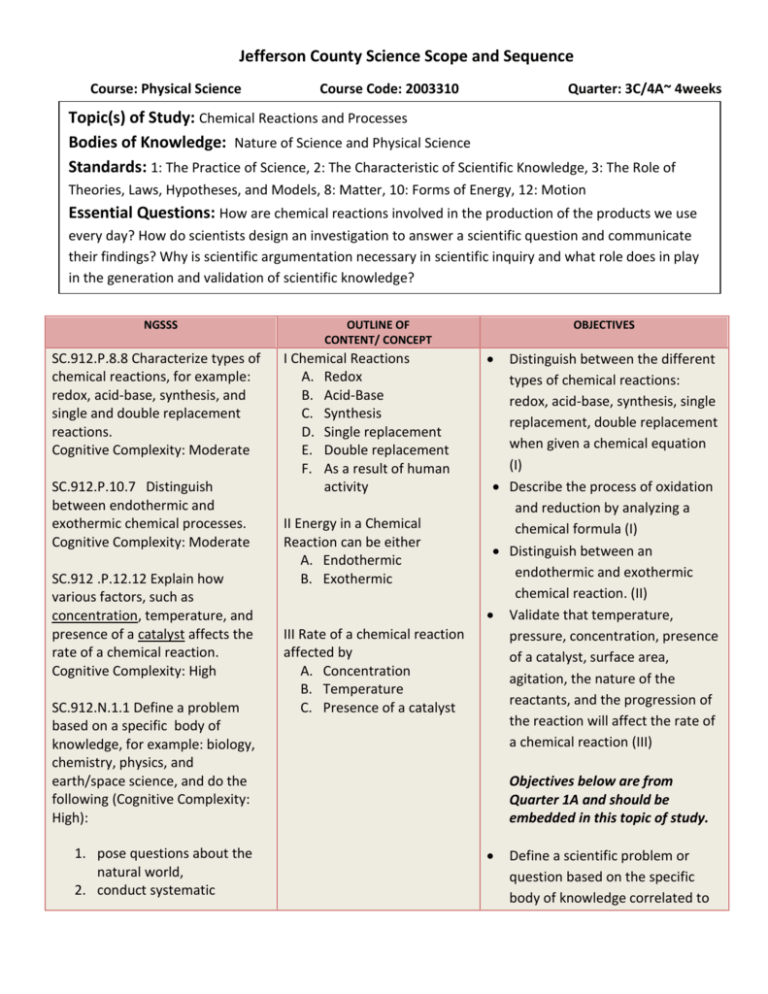
Jefferson County Science Scope and Sequence Course: Physical Science Course Code: 2003310 Quarter: 3C/4A~ 4weeks Topic(s) of Study: Chemical Reactions and Processes Bodies of Knowledge: Nature of Science and Physical Science Standards: 1: The Practice of Science, 2: The Characteristic of Scientific Knowledge, 3: The Role of Theories, Laws, Hypotheses, and Models, 8: Matter, 10: Forms of Energy, 12: Motion Essential Questions: How are chemical reactions involved in the production of the products we use every day? How do scientists design an investigation to answer a scientific question and communicate their findings? Why is scientific argumentation necessary in scientific inquiry and what role does in play in the generation and validation of scientific knowledge? NGSSS SC.912.P.8.8 Characterize types of chemical reactions, for example: redox, acid-base, synthesis, and single and double replacement reactions. Cognitive Complexity: Moderate SC.912.P.10.7 Distinguish between endothermic and exothermic chemical processes. Cognitive Complexity: Moderate SC.912 .P.12.12 Explain how various factors, such as concentration, temperature, and presence of a catalyst affects the rate of a chemical reaction. Cognitive Complexity: High SC.912.N.1.1 Define a problem based on a specific body of knowledge, for example: biology, chemistry, physics, and earth/space science, and do the following (Cognitive Complexity: High): 1. pose questions about the natural world, 2. conduct systematic OUTLINE OF CONTENT/ CONCEPT I Chemical Reactions A. Redox B. Acid-Base C. Synthesis D. Single replacement E. Double replacement F. As a result of human activity II Energy in a Chemical Reaction can be either A. Endothermic B. Exothermic III Rate of a chemical reaction affected by A. Concentration B. Temperature C. Presence of a catalyst OBJECTIVES Distinguish between the different types of chemical reactions: redox, acid-base, synthesis, single replacement, double replacement when given a chemical equation (I) Describe the process of oxidation and reduction by analyzing a chemical formula (I) Distinguish between an endothermic and exothermic chemical reaction. (II) Validate that temperature, pressure, concentration, presence of a catalyst, surface area, agitation, the nature of the reactants, and the progression of the reaction will affect the rate of a chemical reaction (III) Objectives below are from Quarter 1A and should be embedded in this topic of study. Define a scientific problem or question based on the specific body of knowledge correlated to Jefferson County Science Scope and Sequence observations, 3. examine books and other sources of information to see what is already known, 4. review what is known in light of empirical evidence, 5. plan investigations, 6. use tools to gather, analyze, and interpret data (this includes the use of measurement in metric and other systems, and also the generation and interpretation of graphical representations of data, including data tables and graphs), 7. pose answers, explanations, or descriptions of events, 8. generate explanations that explicate or describe natural phenomena (inferences), 9. use appropriate evidence and reasoning to justify these explanations to others, 10. communicate results of scientific investigations, and 11. evaluate the merits of the explanations produced by others. SC.912.N.2.5 Describe instances in which scientists' varied backgrounds, talents, interests, and goals influence the inferences and thus the explanations that they make about observations of natural phenomena and describe that competing interpretations (explanations) of scientists are a strength of science as they are a source of new, testable ideas that have the potential to add new the Physical Science course Use appropriate reference materials to support scientific investigations of various types, such as systematic observation or experiments Explain that science is based on evidence based facts Determine tools and methods that should be used to collect valid data Describe the role consensus plays in the historical development of a theory in Physical Science Give examples of how advances in technology have affected scientific theories and laws Give examples of visual/physical, mathematical, and conceptual models as used in science Describe the limitations and misconceptions perceived by models Recognize that scientists who make contributions to scientific knowledge come from all kinds of backgrounds and possess varied talents, interests, and goals Jefferson County Science Scope and Sequence evidence to support one or another of the explanations Cognitive Complexity: High SC.912.N.3.1 Explain that a scientific theory is the culmination of many scientific investigations drawing together all the current evidence concerning a substantial range of phenomena; thus, a scientific theory represents the most powerful explanation scientists have to offer. Cognitive Complexity: High SC.912.N.3.2 Describe the role consensus plays in the historical development of a theory in any one of the disciplines of science. Cognitive Complexity: Moderate SC.912.N.3.5 Describe the function of models in science, and identify the wide range of models used in science. Cognitive Complexity: Moderate
